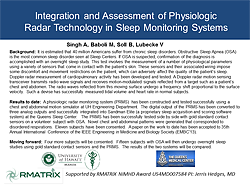Soll, Bruce MD
Assistant Clinical Professor
Department of Medicine
John A. Burns School of Medicine Director of Medical Education
Queen’s Medical Center 808.547.4966
soll@hawaii.edu
Scientific Highlights
2012-2013 Pilot Project AwardIntegration and Assessment of Physiologic Radar Technology in Sleep Monitoring Systems  Click the preview to view a larger version. Click the preview to view a larger version.
Description
Obstructive Sleep Apnea (OSA) is a common sleep disorder. It is estimated to affect over 40 million US patients. This disorder is associated with significant morbidity. Accurate screening and diagnosis is necessary to lessen the burden of this disorder on patients, their families, and the community. The current gold standard for diagnosis of OSA is a Type 1 diagnostic study in an accredited sleep center. Type 3 and 4 portable monitoring systems are available for screening patients in their homes. All of these devices use conventional sensors that contact the patient. These contacts and their associated wires negatively impact the patient’s quality of sleep. New non-contact physiologic radar monitoring is now available that allows for unique wireless monitoring of some of the classic sleep variables. The investigators of this study will develop a physiologic radar monitoring system (PRMS) that will measure respirations and heart rate, chest wall and abdominal motion, and patient activity. They will integrate this monitor with a gold standard Type 1 sleep monitoring system, the Sandman Elite Sleep Acquisition System. They will then study 15 OSA patients with the conventional system and the PRMS. They will then compare and contrast the data from the two systems. It is expected that the PRMS will compare favorably with the conventional monitored variables and add value to the gold standard. It also expected that this study will lead to future studies using PRMS on different patients groups such as Hawaiian and Pacific Islanders in remote island locations. Health Initiative
Nutrition & Metabolic; Respiratory Collaboration & Partnerships
Queen’s Medical Center, Oahu, HI Progress
Results to date: A physiologic radar monitoring system (PRMS) has been constructed and tested successfully using a chest and abdominal motion simulator at UH Engineering Department. The digital output of the PRMS has been converted to three analog outputs and successfully integrated into Sandman Elite (a proprietary sleep acquisition and scoring software system) at the Queens Sleep Center. The PRMS has been successfully tested side by side with gold standard contact sensors on a volunteer subject with OSA. Novel chest and abdominal patterns were generated that corresponded to disordered respirations. Eleven subjects have been consented. A paper on the work to date has been accepted to 35th Annual International Conference of the IEEE Engineering in Medicine and Biology Society (EMBC’13). Moving forward: Four more subjects will be consented. Fifteen subjects with OSA will then undergo overnight sleep studies using gold standard contact sensors and the PRMS. The results of the two systems will be compared.
|




